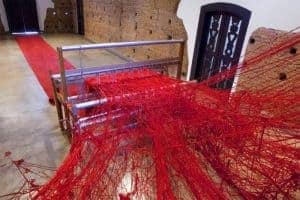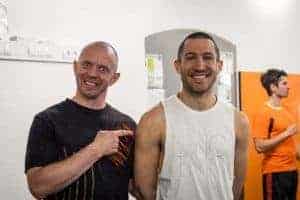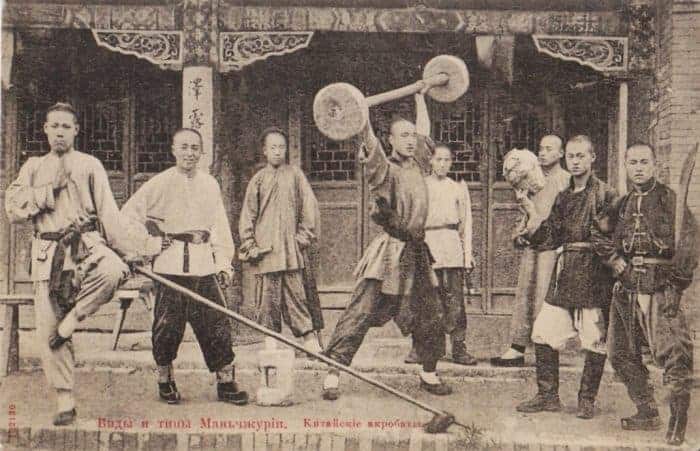One of the more interesting insights that came out of my European adventure was the coming together of a syllabus I ended up naming ‘Body Awakening’. I had started my adventure with something of an unexpected workshop. Emmet and I had been sharing our explorations online for some time, throwing suggestions at each other to use as experiments on ourselves or the people training with us. Given that my first stop in Europe was to be Germany it only seemed prudent to meet this mad scientist in person. What spawned from this meeting was an experimental workshop that we co-taught in Berlin which was aptly titled “Repatterning the Human Form” – a name which was suggested by Dave (of course). We had a lot of fun that weekend as you can see from the video below – but there was something missing.
No doubt we had presented a virtuous collection of exercises. This said it was not really linked together in any meaningful way and was reasonably chaotic as a result. It just so happened that around this time I learned about an appropriate german phrase: der rote Faden des Erzählens. It means “the red thread of the narrative” – a common theme that weaves itself throughout a story and ties it together at the end. It was precisely this red thread that was missing from what I was presenting. And so I set to work with my metaphorical needle weaving together what would eventually become my first craft piece*.

There was a significant amount of fat that needed to be trimmed. Ido Portal’s Movement Culture was blowing up and dozens of people were beginning to appear – teaching variations of body weight strength, capoeira-eque play drills and practical/performance based flexibility. I made a conscious decision not to add to the noise; as there were already plenty of very qualified people teaching such things and so I removed a great deal of this kind material from my workshops. Instead I focused on the exercises and approaches I had that were somewhat unique. Unsurprisingly these were also the elements that most often garnered inquisitive attention from attendees at my workshops.
I tested and refined the material over a number of workshops and with my students, making sure to address each major part of the body and also that my red thread was properly woven through. The theme was simple but effective; a syllabus of exercises that would awaken dormant tissues in the body in ways that would complement, or even better, ‘supercharge’ any kind of already existing physical practice.

While I had an inkling that this was an auspicious creation before setting it onto the public, I did not in any way expect the results that came. It worked. It worked really, really well. Many of my students were writing back to me with extraordinary excitement. I had also presented the material to Roman Pallesits and the rest of the crew at team Pallesits Physiotheraputen. Roman, bless his crazy heart, immediately decided to implement this material with his patients from the broken and sedentary to high profile athletes such as Ballerines from the Vienna State Ballet. Over 100 clients per week each getting a healthy dose of the body awakening – aiding rehabilitation in some of these people!. The material was never created with rehab in mind but it seemed that awakening these dormant areas can have a significant impact on the body’s capacity to remedy pain and dysfunction. While not a miracle cure-all, it is most certainly a virtuous tool to have in the kit – especially when in the hands of people as highly proficient as Roman and his team.

The good news is that the time needed is not great. Five to ten minutes per element/video each day is all that is needed. Start a timer and explore the exercise continuously until it sounds. 30 – 90 days of daily practice will be enough to spark a revolution of awakening in the targeted tissues. What I tend to do with my students is give them a period like this with one or two elements to focus on each day (around 10 – 15 minutes worth) and then cycle to something new for the next period. That way they do not need to be imprisoned by their training but within a year they still make epic progress in almost every element.
This mode of practice was very much inspired by the Chinese approach to training martial arts. Training in these traditional methods was always a daily affair and the only acceptable excuse for skipping your daily practice was illness or death. Almost every family of martial arts has a selection of simple exercises that are trained by the beginning student to awaken the various bodily qualities needed for the training to come. These exercises are called ‘jibengong’ – basic foundational training. They act simultaneously as a filter to clear out the insincere students and as the very secret that eventually allowed the masters their extraordinary skill, too. Three years was the typical beginning period and a strict traditional school would often not let a beginner do anything but the jibengong for this entire period. It is also said that “the secret protects itself” – the impatient students who would avoid these basics would never gain the extraordinary skills even if they knew all the so-called ‘advanced’ practices.
Like jibengong, the body awakening syllabus requires a very genuine effort. Without this, it will all be for naught – you must try earnestly to feel what the exercise is aimed at awakening. Even if you cannot feel anything happening the attempt will still breathe life into the area. For the seasoned practitioner it is even more important; any idea that you can already feel everything should be incinerated for there is always more detailed awareness to be drawn out. I am still finding entire sheets of my glutes that are soundly sleeping after many years of practice which I must now persuade to awaken with further practice.
The other mystery of this syllabus is that the results do not necessarily come during or at the end of the practice session. There was one moment that I still very clearly remember. I had been making decent progress on the lifting with the armpits exercises and it felt like my traps were quite soft when I lifted my arms. On one particular day I was reaching for some food in the cupboard, far removed from any thoughts about practice of any kind. Suddenly my traps relaxed to a depth I had not previously experienced. A whole layer of tension that I had no idea existed popped into my awareness and then immediately dissolved leaving me in one of the most relaxed states I had ever been in up until that point. My arms moved overhead effortlessly and I went about my day with a smiling shoulders.

Unfortunately for me the results that come from this mode of practice do not translate well to social media. I can hardly make a video of me lifting my arms overhead with soft traps or climbing 500 stairs while proclaiming **how fucking awesome!!** it feels to have the glutes doing most of the work instead of the quads burning out after 50 steps. It is very difficult to give an idea or a picture of what this feels like because until it has been directly experienced there no point of reference and it doesn’t make any sense or have much of an attractive pull.
The only way to get the direct experience is to practice for an ongoing period. Even the often revolutionary experiences that people have had in my workshops are completely insignificant compared to what is possible with ongoing practice – more like a taste-tester than the actual meal itself.
If you’ve read this far and are interested in said direct experiences, then you have a few options. The best is to get along to one of our upcoming events – I typically teach a decent amount of the body awakening material at every workshop I present at. The other option is to take yourself through the practices. I have tutorials for almost the entire syllabus available on the tutorials page. You can find the tutorials that are part of the Body Awakening Syllabus by clicking here.
Happy training!


